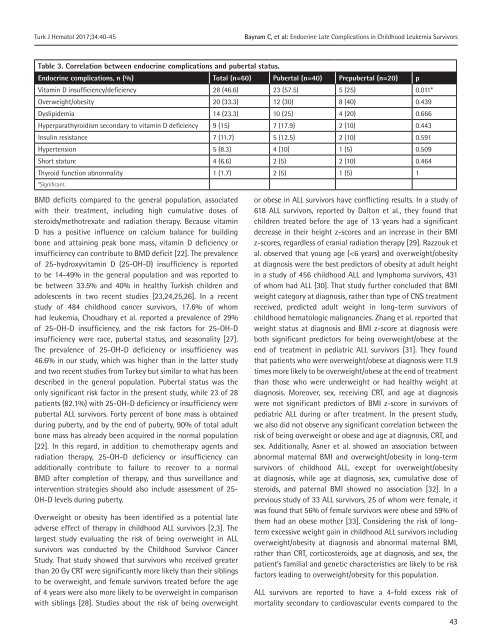Turkish Journal of Hematology Volume: 34 - Issue: 1
Create successful ePaper yourself
Turn your PDF publications into a flip-book with our unique Google optimized e-Paper software.
Turk J Hematol 2017;<strong>34</strong>:40-45<br />
Bayram C, et al: Endocrine Late Complications in Childhood Leukemia Survivors<br />
Table 3. Correlation between endocrine complications and pubertal status.<br />
Endocrine complications, n (%) Total (n=60) Pubertal (n=40) Prepubertal (n=20) p<br />
Vitamin D insufficiency/deficiency 28 (46.6) 23 (57.5) 5 (25) 0.011*<br />
Overweight/obesity 20 (33.3) 12 (30) 8 (40) 0.439<br />
Dyslipidemia 14 (23.3) 10 (25) 4 (20) 0.666<br />
Hyperparathyroidism secondary to vitamin D deficiency 9 (15) 7 (17.9) 2 (10) 0.443<br />
Insulin resistance 7 (11.7) 5 (12.5) 2 (10) 0.591<br />
Hypertension 5 (8.3) 4 (10) 1 (5) 0.509<br />
Short stature 4 (6.6) 2 (5) 2 (10) 0.464<br />
Thyroid function abnormality 1 (1.7) 2 (5) 1 (5) 1<br />
*Significant.<br />
BMD deficits compared to the general population, associated<br />
with their treatment, including high cumulative doses <strong>of</strong><br />
steroids/methotrexate and radiation therapy. Because vitamin<br />
D has a positive influence on calcium balance for building<br />
bone and attaining peak bone mass, vitamin D deficiency or<br />
insufficiency can contribute to BMD deficit [22]. The prevalence<br />
<strong>of</strong> 25-hydroxyvitamin D (25-OH-D) insufficiency is reported<br />
to be 14-49% in the general population and was reported to<br />
be between 33.5% and 40% in healthy <strong>Turkish</strong> children and<br />
adolescents in two recent studies [23,24,25,26]. In a recent<br />
study <strong>of</strong> 484 childhood cancer survivors, 17.6% <strong>of</strong> whom<br />
had leukemia, Choudhary et al. reported a prevalence <strong>of</strong> 29%<br />
<strong>of</strong> 25-OH-D insufficiency, and the risk factors for 25-OH-D<br />
insufficiency were race, pubertal status, and seasonality [27].<br />
The prevalence <strong>of</strong> 25-OH-D deficiency or insufficiency was<br />
46.6% in our study, which was higher than in the latter study<br />
and two recent studies from Turkey but similar to what has been<br />
described in the general population. Pubertal status was the<br />
only significant risk factor in the present study, while 23 <strong>of</strong> 28<br />
patients (82.1%) with 25-OH-D deficiency or insufficiency were<br />
pubertal ALL survivors. Forty percent <strong>of</strong> bone mass is obtained<br />
during puberty, and by the end <strong>of</strong> puberty, 90% <strong>of</strong> total adult<br />
bone mass has already been acquired in the normal population<br />
[22]. In this regard, in addition to chemotherapy agents and<br />
radiation therapy, 25-OH-D deficiency or insufficiency can<br />
additionally contribute to failure to recover to a normal<br />
BMD after completion <strong>of</strong> therapy, and thus surveillance and<br />
intervention strategies should also include assessment <strong>of</strong> 25-<br />
OH-D levels during puberty.<br />
Overweight or obesity has been identified as a potential late<br />
adverse effect <strong>of</strong> therapy in childhood ALL survivors [2,3]. The<br />
largest study evaluating the risk <strong>of</strong> being overweight in ALL<br />
survivors was conducted by the Childhood Survivor Cancer<br />
Study. That study showed that survivors who received greater<br />
than 20 Gy CRT were significantly more likely than their siblings<br />
to be overweight, and female survivors treated before the age<br />
<strong>of</strong> 4 years were also more likely to be overweight in comparison<br />
with siblings [28]. Studies about the risk <strong>of</strong> being overweight<br />
or obese in ALL survivors have conflicting results. In a study <strong>of</strong><br />
618 ALL survivors, reported by Dalton et al., they found that<br />
children treated before the age <strong>of</strong> 13 years had a significant<br />
decrease in their height z-scores and an increase in their BMI<br />
z-scores, regardless <strong>of</strong> cranial radiation therapy [29]. Razzouk et<br />
al. observed that young age (

















